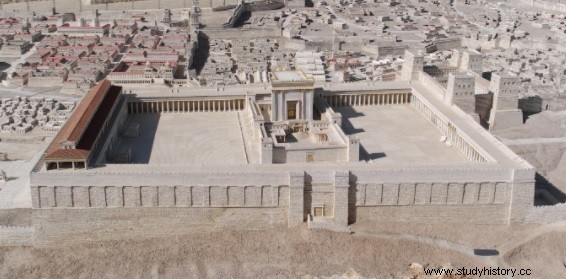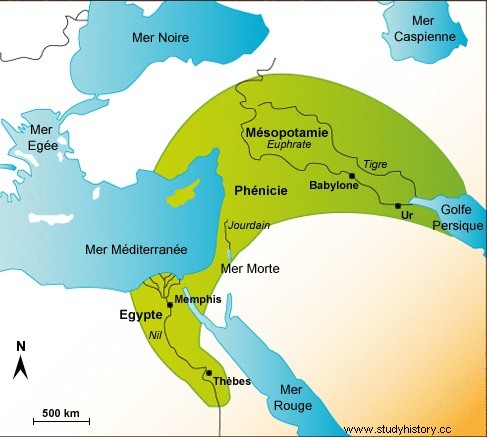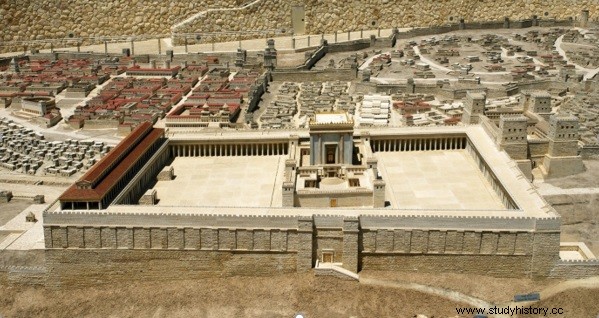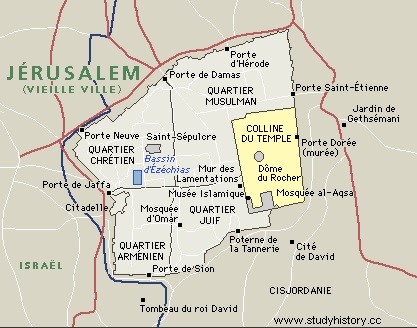 A holy city in Palestine and a place of pilgrimage for Jews, Christians and Muslims, the city of Jerusalem appeared in history from the beginning of antiquity. Around 2000 BC, the city developed and quickly became one of the main city-states of the so-called Canaanite period before coming under Egyptian domination. Conquered by King David in the tenth century BC, it became the capital of a kingdom and a religious center for the Hebrews, famous for its temple built by Solomon. Destroyed several times, Jerusalem came under Roman rule in the 1st century.
A holy city in Palestine and a place of pilgrimage for Jews, Christians and Muslims, the city of Jerusalem appeared in history from the beginning of antiquity. Around 2000 BC, the city developed and quickly became one of the main city-states of the so-called Canaanite period before coming under Egyptian domination. Conquered by King David in the tenth century BC, it became the capital of a kingdom and a religious center for the Hebrews, famous for its temple built by Solomon. Destroyed several times, Jerusalem came under Roman rule in the 1st century.
Jerusalem between legend, memory and history
Few cities arouse as much passion as Jerusalem, through legends and history. This word passion is also taken from the Latin passio meaning “suffering”. As for the legends, they most often include prophets from the Bible, from Jewish and Christian tradition, but also from Islam. In the etymological sense, these legends have the meaning of "what must be read". Few cities have so many places where sediments of evolving collective memory accumulate, relying heavily on the media and on names.
In Jerusalem, the smallest street, even the smallest stone, tells Something. Almost everything is a trace left by a historical or legendary event. Memory constantly comes to transform the past. Let's illustrate this with an example:
At the beginning of the 20th century, an archaeologist identified the original site of the city of Jerusalem, which lies south of the medieval city walls. This archaeologist was a religious, a brother of the Dominican order:Father Vincent, a member of the Bible school in Jerusalem. This school is an institution founded in the second third of the 19th century where exegesis and archeology of the Holy Land are studied. This scholar was looking for traces of biblical Jerusalem. He calls the original city “the city of David”.
David is said to have united the Israelite tribes in the land of the Canaanites. David conquered Jerusalem in 1010 before the birth of Christ according to biblical chronology. But are we sure of the existence of David? We only know about him what the Bible says. External testimonies are quite ambiguous:stelae engraved in Aramaic which mention kings from the "house of David". This testimony confirms that David is the founding ancestor of a dynasty that reigned over Jerusalem, but nothing indicates that he existed, and we do not know more.
Prehistory
 In the very long term, Jerusalem belongs to this region which is called the "fertile crescent" and which the We can also call Syria (but not in the sense of the current country) or even Bilad Al-Sham. The coastal region is called Palestine. The Fertile Crescent is one of the first regions in the world where cities such as Jericho were formed, which was continuously occupied for more than five millennia from -4500.
In the very long term, Jerusalem belongs to this region which is called the "fertile crescent" and which the We can also call Syria (but not in the sense of the current country) or even Bilad Al-Sham. The coastal region is called Palestine. The Fertile Crescent is one of the first regions in the world where cities such as Jericho were formed, which was continuously occupied for more than five millennia from -4500.
In Egypt or Mesopotamia, we notice a displacement of urban sites over time:Babylon is not very far from Ctesiphon which was the capital of the Persian Emperors until the 1st century BC , and Baghdad is not very far from the latter either and there is no continuity between these three capitals. Similarly in Egypt, Memphis is not very far from Fustat which is itself close to Cairo founded later, we observe there a displacement that there is not in the Bilad Al-Sham where it is all the contrary:urban sites are very rarely abandoned despite periods of destruction.
The latter therefore have material continuity. Vestiges of the past can be more or less visible and more or less constraining for life. In the city of Damascus, the Umayyads founded the Umayyad Mosque in 710. The latter stands on the site of the former Saint John the Baptist Cathedral, it is this continuity that we find in Jerusalem.
From the origins to the destruction of the first temple (586 BC)
It is believed that the end of the 4th millennium BC marks the beginning of the occupation of the land of Jerusalem. The construction of a first fortress on the site dates back to the years 1700 BC at a time which is before the advent of the kingdom of Israel, but even before this time, Jerusalem has a political importance in the region, that can be measured because the name of this city is attested in Egyptian documentation, more precisely in the tablets found on the site of Tel El-Amarna, but the city only experienced significant urban development from the 8th century BC our era.
The city has been the capital of a kingdom founded by a group who call themselves "Hebrews" or "Israelites" for about two centuries. This group, fixes its origins in Mesopotamia but it is rather probable that it is originating in the country of Canaen attracting the world of Mesopotamia and Egypt. It is mentioned for the first time in 1207 BC on the stele of Merneptah, so it has an ancient political existence. Israel is actually two kingdoms:the kingdom of Israel in the northern part and the kingdom of Judah in the south.
 The presence of cemeteries, the extension of the city and the wealth of its ancestors, the development of important complex hydraulic infrastructures, such as the tunnel of Siloam, 500m long, dug in the rock, and which connects the source of Chihon to a reservoir located in the city of David, show that the city prospers. This prosperity is explained by the religious influence from the construction of a temple dedicated to Yahweh on the mountain of the Lord. There is no archaeological record of the first temple mentioned in the Book of Kings but it is a modest temple with a vestibule called the "Holy of Holies" where the ark of the covenant rests with the tablets of Mount Sinai. Only the high priest can enter it and only on the day of Yom Kippur. At the time it was a sacrificial religion like everywhere in the Middle East, not monotheism but monolatry. This monolatry gradually tends towards monotheism in a fundamentally polytheistic world.
The presence of cemeteries, the extension of the city and the wealth of its ancestors, the development of important complex hydraulic infrastructures, such as the tunnel of Siloam, 500m long, dug in the rock, and which connects the source of Chihon to a reservoir located in the city of David, show that the city prospers. This prosperity is explained by the religious influence from the construction of a temple dedicated to Yahweh on the mountain of the Lord. There is no archaeological record of the first temple mentioned in the Book of Kings but it is a modest temple with a vestibule called the "Holy of Holies" where the ark of the covenant rests with the tablets of Mount Sinai. Only the high priest can enter it and only on the day of Yom Kippur. At the time it was a sacrificial religion like everywhere in the Middle East, not monotheism but monolatry. This monolatry gradually tends towards monotheism in a fundamentally polytheistic world.
The Bible comes from the name of the city Byblos where papyri were made (which will give the Greek word biblio). The first five books of the Bible, the Torah, are a series of general rules of daily life, it is the law, revealed by God. This dimension is important because it is one of the main legacies that Islam will take up. The centrality of the Jerusalem temple is expressed in the desire to centralize worship in Jerusalem despite a few exceptions such as the Temple of Elephantine in Egypt (Aswan). The armies of Nebuchadnezzar seize Jerusalem and destroy the first temple in 586. The destruction of the city is partial, part of the population falls into captivity in Babylon (current Iraq). It is the birth certificate of the largest Jewish community outside Judea.
Jerusalem at the time of the second temple (538 BC – 70 AD)
There is a change of domination in the Near East in favor of a new Empire:Persia. This empire extends its domination over the Bilad Al-Sham. In 538 BC, Cyrus II gave permission to rebuild their temple to the inhabitants of Jerusalem, this construction will take several years to restore the religious role of Jerusalem. Under the Achaemenid dynasty (Persian culture), then after the conquest of Alexander under the Seleucid dynasty (Hellenic culture), Jerusalem knows under the tutelage of external powers the second temple, but despite this Hellenic culture, the city retains an originality . In 167 BC, Antiochos IV took forced measures of Hellenization, the most brutal of which was the introduction of the cult of Olympian Zeus in the temple of Yahweh.
It will be the spark of a revolt that will last until 141 BC and will bear the name of "revolt of the Maccabees". In 164 BC, the cult of Yahweh was reestablished in the temple and gave a feast, the Hannuka, commemorating this reconquest of the cult. In 141 BC, this revolt led to the restoration of an independent kingdom with Jerusalem as its capital and Yahweh as the only God. At its head, a dynasty:the Hasmoneans, which took power after the revolt. It is a dynasty of a religious nature where the sovereign is the High Priest but despite the nature of this power, the Hasmoneans became Hellenized and this resulted in the construction of Hellenistic-type funerary monuments. The most sumptuous builder is King Herod who reigns from 40 BC to 4 BC:he initiates colossal works in Jerusalem, notably on the temple mount. He will level the temple mount, make it an esplanade, clearly separate the temple from the rest of the city. Only followers of Yahweh's culture can enter the temple precincts and Gentiles are restricted in their access, and must confine themselves to the Pavis des Gentiles.
The works initiated by Herod in 19 BC continued until 63. The temple was desecrated by Pompey in 64 BC, which badly inaugurated relations between Jerusalem and the Roman guardianship. The Romans, who had an essentially public and peaceful relationship with religion, were surprised by the exclusive nature of the Jewish religion. The temple in Jerusalem adapted to the growing influence of Rome because sacrifices were made there. The imperial cult is present there. In 44, Rome decided to impose its direct administration on Jerusalem, which marked the end of the Hasmonean kingdom. This direct administration did not solve the desecrations, which led to a revolt of the Judeans in 66 which was very harshly repressed by the Roman legions.
In 70, the Roman armies besieged Jerusalem, the rebels took refuge in the temple and at the end of summer 70, after fierce combat, the Romans s seize Jerusalem and the fires destroy the second temple, the city is sacked.
Jerusalem in Roman times
 The destruction of the second temple is slow to take hold. It is a progressive farewell to the temple of Jerusalem without hope of reconstruction unlike the first temple. Religion ceases to be sacrificial because it no longer has a temple and therefore no longer a High Priest, it is then led by specialists in the law:the rabbis. We pass to a religion of the Book and the faithful meet in what is called in Greek the synagogè which means “the assembly”. The faithful remain haunted by the lamentation of the loss of Jerusalem and the temple. Why this feeling of definitive loss?
The destruction of the second temple is slow to take hold. It is a progressive farewell to the temple of Jerusalem without hope of reconstruction unlike the first temple. Religion ceases to be sacrificial because it no longer has a temple and therefore no longer a High Priest, it is then led by specialists in the law:the rabbis. We pass to a religion of the Book and the faithful meet in what is called in Greek the synagogè which means “the assembly”. The faithful remain haunted by the lamentation of the loss of Jerusalem and the temple. Why this feeling of definitive loss?
Because the Romans will take measures of exclusion against the faithful following a final revolt which broke out in 132 and led by Bar Jokhba and his men until 135. This revolt was crushed by the Roman legions, but to definitively remove the risk of revolt, the Romans took drastic measures:prohibition of circumcision in Judea, prohibition of Shabbat in Judea, prohibition of Torah study in Judea (in Judea only, and not in the whole Empire), ban on worshipers entering Jerusalem except once a year. It was the only city in the Roman Empire that became off-limits to Jews.
This authorization becomes a rite known today with the wailing wall where the Jews went to mourn the loss of the temple and of Jerusalem. This wall is located southeast of the Herodian temple. Since 135, with the Emperor Hadrian, Israel no longer exists as an independent kingdom and the word by which the faithful called themselves (yehudim used to designate the first Judeans) became an ethnonym of people in exile. From then on, yehudim no longer translates as "Judean" but as "Jew".
Only the esplanade, the underground cisterns, the surrounding wall with its entrances, remain. The temple mount, in the Middle Ages, was a real "reservoir" for materials, in particular stones and the practice of re-use, the reuse of materials-vestiges will be very developed in the Middle Ages, and in particular in Cairo as in most cities having a heavy historical past.
Bibliography
- Dictionary of the Bible, André-Marie Gérard. Robert Laffont, 1989.
- History of Jerusalem, by Michael Jasmin. What do I know, 2018.
